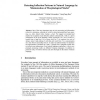Free Online Productivity Tools
i2Speak
i2Symbol
i2OCR
iTex2Img
iWeb2Print
iWeb2Shot
i2Type
iPdf2Split
iPdf2Merge
i2Bopomofo
i2Arabic
i2Style
i2Image
i2PDF
iLatex2Rtf
Sci2ools
CIARP
2004
Springer
2004
Springer
Detecting Inflection Patterns in Natural Language by Minimization of Morphological Model
One of the most important steps in text processing and information retrieval is stemming—reducing of words to stems expressing their base meaning, e.g., bake, baked, bakes, baking → bak-. We suggest an unsupervised method of recognition such inflection patterns automatically, with no a priori information on the given language, basing exclusively on a list of words extracted from a large text. For a given word list V we construct two sets of strings: stems S and endings E, such that each word from V is a concatenation of a stem from S and ending from E. To select an optimal model, we minimize the total number of elements in S and E. Though such a simplistic model does not reflect many phenomena of real natural language morphology, it shows surprisingly promising results on different European languages. In addition to practical value, we believe that this can also shed light on the nature of human language.
| Added | 01 Jul 2010 |
| Updated | 01 Jul 2010 |
| Type | Conference |
| Year | 2004 |
| Where | CIARP |
| Authors | Alexander F. Gelbukh, Mikhail Alexandrov, Sang-Yong Han |
Comments (0)

